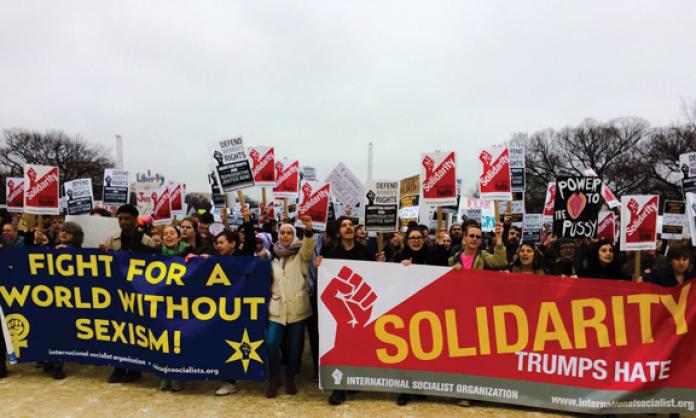It is very dangerous times in the USA, with Trump and his coterie of alt-right reactionaries, headed by Steve Bannon, ensconced in the White House. But it is not all doom and despair.
The US is not simply an appalling sea of reaction. It is an increasingly polarised society in which increasing numbers of people feel the need to take a stand against the emboldened far right. Support for radical left wing ideas is surging.
The most important reflection of this trend is the wave of protests that has confronted Trump’s presidency. The women’s protest the day after his inauguration drew millions into the streets across the country, in possibly the largest demonstrations in US history.
This was followed by militant protests that besieged airports in response to the Muslim ban. Protests have continued unabated since then, and more mass mobilisations are planned for coming months.
Considerable numbers of people have also realised that one-off demonstrations are not enough, that they have to become active on a serious, ongoing basis.
People are searching for ideas that challenge the whole direction of capitalist politics in the US and offer a way forward for working class people and all the oppressed. Socialism is no longer a dirty word, and many thousands are joining socialist organisations.
It was not just Trump’s election that sparked widespread interest in socialist ideas. The complete dysfunction of US capitalism, falling living standards, the growing chasm between rich and poor and blatant racism had fuelled the search for a radical left wing alternative, especially among young people.
The 2007-08 financial crisis, in which millions of workers lost their jobs and often their homes while the leading banks received billions of dollars in taxpayer-funded bailouts, was a turning point. In the aftermath, most US residents looked positively on the message of Occupy Wall Street: that the mass of people – the 99 percent – were being exploited by a tiny super-rich minority – the 1 percent.
Gallup polls in 2010 and 2012 showed that 35 percent of people had a positive view of socialism. A 2011 Pew Poll showed that this true of 49 percent of those under 30.
The self-declared democratic socialist Bernie Sanders’ campaign for the Democratic Party presidential nomination energised this sentiment. Sanders’ attacks on Wall Street bankers and his support for a national health insurance scheme and free university education resonated with tens of millions.
Surveys showed that more than 40 percent of likely Democratic attendees to the Iowa caucuses said they were socialists. Thirty-one percent of Democrats in the New Hampshire primary identified as socialists. For under-35s, it was more than half. Even in South Carolina, in the deep south, a Bloomberg poll indicated that 37 percent of Democrat voters supported socialism.
Trump’s victory turned that broad sympathy for socialism into active commitment. For thousands of people, that meant getting active and organised in a socialist group.
The Democratic Socialists of America (DSA), which strongly supported Sanders’ campaign and is close to him politically, has so far been the main beneficiary of the recruitment surge. Immediately after Trump’s election, DSA membership reportedly jumped by a few thousand. The trend has continued. DSA’s paid-up membership is currently 17,000, up from 6,500 in May 2016.
A range of other socialist groups such as Socialist Alternative and the International Socialist Organisation (ISO) have gained hundreds of new members. In particular, campus socialist clubs have grown rapidly. Socialist public meetings have attracted large new audiences all across the country, even in small cities like Portland, Maine, where the ISO branch has grown rapidly.
Socialists have played an important role in initiating a number of protests against Trump and in attempting to establish organising committees, involving a wide variety of people and organisations, to cohere ongoing resistance. The ISO, for example, played a key role in calling counterdemonstrations to defend Planned Parenthood clinics from anti-abortion bigots.
At this early stage of the radicalisation, it isn’t surprising that more moderate organisations such as the DSA, which works in the Democratic Party, are the main beneficiaries rather than explicitly revolutionary organisations such the ISO, which argues for a decisive break with the Democrats.
People’s ideas of what socialism is all about are still in many cases fuzzy. It is commonly seen as a generous, caring society with a more even distribution of wealth and a decent social safety net – something like what supposedly exists in Sweden.
As the movement against Trump develops and people gain practical experience of the role of the Democrats in holding back the struggle, political opinions can move sharply to the left and become more open to a fully developed Marxist critique of capitalism.
The mass demonstrations against Trump are incredibly exciting and positive. The tide is shifting.
But a series of demonstrations, however large, will not be sufficient to defeat Trump. It will take a sustained militant movement that begins to galvanise the industrial power of workers to shut down the very workings of the system.
The collective power of workers is at the heart of genuine socialism. Workers produce all the wealth of society. They run the hospitals, the schools, the public transport systems and all the services we need in our daily lives.
When workers come together and act collectively, they can not only cut off the bosses’ profits but also begin to challenge the whole dog eat dog logic of capitalism. They can not only bring down an abomination like Donald Trump; they can create an entirely new social order – a genuinely democratic society of equality and human freedom. That’s what socialism is all about.
It is still very early days in the US. The movement against Trump faces incredible challenges and is sure to suffer defeats and setbacks as well as leaps forward.
However, an exciting new radicalisation is under way that has the potential to transform politics and open up the space for a greatly revived socialist movement in the belly of the beast. That will have repercussions worldwide, not least in Australia, which is so interconnected with US capitalism.











